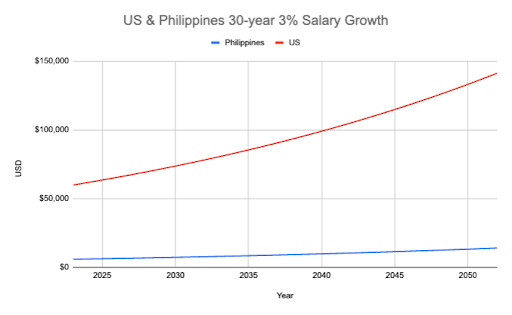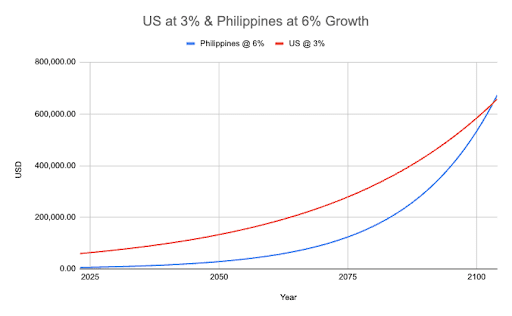Welcome to this week’s Gone Global! Join us as we unpick the top stories and insights emerging from global business. Let’s start!
The Competitive Edge of Emerging Market Salaries
Salaries in the US are the envy of the rest of the world. Packages worth $50,000-$100,000 are now pretty standard fare.
Meanwhile, in most other places – especially the emerging economies – these numbers are equivalent to a King’s ransom.
Can emerging countries ever catch up to the lofty salaries of the US?
It won’t be easy…
Allow me some quick public math to illustrate my point.
When comparing Philippine salaries to US salaries, there is roughly a 10x difference. Meaning a $6,000 salary in the Philippines is about equivalent to a $60,000 US salary. Currently, the difference between those two salaries is $54,000.
If both salaries rose 3% per year for 30 years, then the difference would remain 90%, but the nominal amount would actually increase.
After 30 years of 3% y-o-y growth, the $6k salary would become $14.1k, and the $60k salary would become $141.4k. So the nominal difference has increased from $54k to $127.2k!
For the Philippines to catch up, its salaries need to grow at a far higher rate.
So what happens if US salaries grow at 3%, and the Philippines at an impressive 6% per year?
Well… not that much.
It still takes a whopping 82 years – hitting $640k in 2104 – for the salaries to reach parity!
But that’s not the whole story.
The face value of a salary is only one perspective. And it’s far from the whole picture.
Purchasing Power Parity:
The cost of living across countries varies widely. This differential is illustrated by Purchasing Power Parity (PPP) analysis. Fancy economists have established that the PPP conversion factor of the Philippines was 19.51 in 2020. Meaning that The Philippines is approximately 20x cheaper than the US.
Inflation:
If everyone’s salary increased, inflation would wipe out much of the gains as goods and services would cost more across the board. So if salaries doubled, and goods and services also doubled, then no one would be any better off.
Young population:
The Philippines has a remarkably young population compared to the US. Its median age is just 25 in the Philippines, with 51% of its people under the age of 24, compared to a median of 38 and 31% under 24 in the US. Equally, birth rates are 73% higher than in the US.
The young and growing population will provide a valuable asset to the Philippines as the developed nations get collectively older. However, the abundant supply will keep salaries lower.
The question for your business
Are you taking advantage of the global salary discrepancies?



 Independent
Independent





















